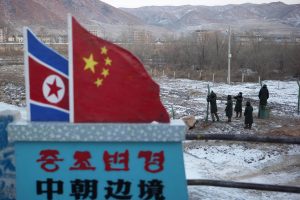Political relations between China and North Korea frequently make headlines – for the latest example, see the exchange of letters by Xi Jinping and Kim Jong Un in late March, just ahead of a North Korean ballistic missile test. We hear less about the economic side of the partnership, and still less about the impact on the lives of people living in the Sino-North Korean border region.
The new book “Decoding the Sino-North Korean Borderlands” seeks to rectify that by looking at how the relationship plays out on the micro-level, on either side of the China-North Korea border. In this interview, two of the volume’s editors, Adam Cathcart of the University of Leeds and Christopher Green of Leiden University, discuss their thoughts on North Korea and China’s approaches to the border region, and the impact on ordinary people.
How does North Korea approach trade with and investment from China? In particular, how does it balance the economic advantages of a more open border with the potential loss of control?
Christopher Green: This question identifies the essential dilemma of North Korea’s leaders: How to maintain authoritarian control over society whilst simultaneously developing the economy to a degree that allows for maintaining the regime’s power. For decades, this dilemma has manifested as a cyclical process of economic opening and retrenchment.
That is not necessarily a conscious decision, but it does have a certain natural economic and political logic to it. Pro-China officials rise and fall, and with them comes and goes pro-Beijing advocacy within the corridors of power in Pyongyang. Yet, while being demonstrably pro-China is treated as a moral failing for a senior North Korean official, that can be set aside when economic conditions demand. Relatively greater openness to China fills the state’s accounts – the more open the country becomes, the more hard currency flows in – but such investments, as time passes, begin to look to the “police” in the police state like unacceptable risks. It goes without saying that North Korea’s leaders also have a very unpopular tendency to spend a significant slice of GDP on weapons programs that antagonize not only the U.S. and its allies, but also the Chinese government. The higher the country’s GDP, the more capital is available for such programs. And if North Korean nuclear tests end up rattling the windows of schools in the Yanbian region of China, how could cross-border trade disruptions not be an outcome?

































